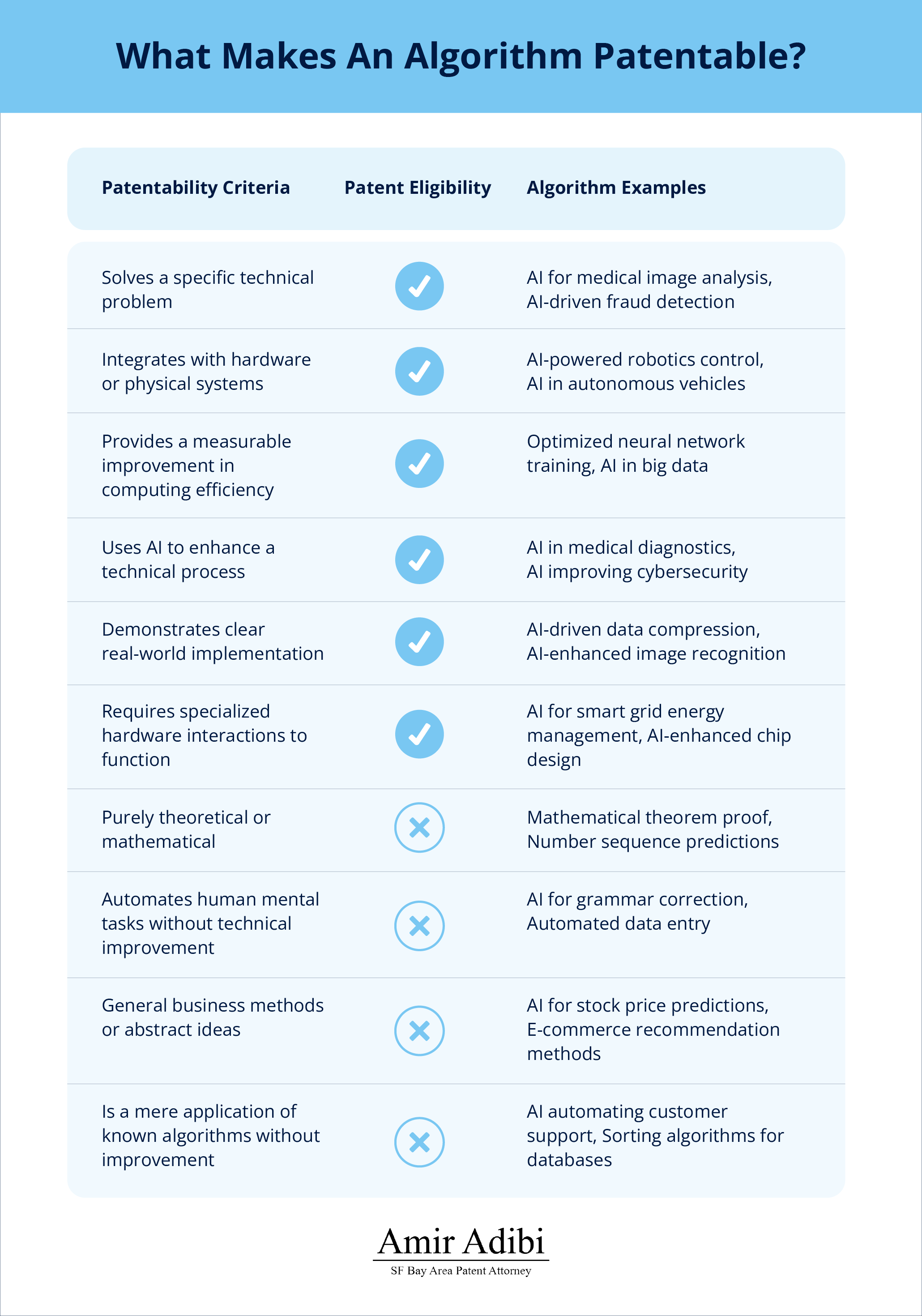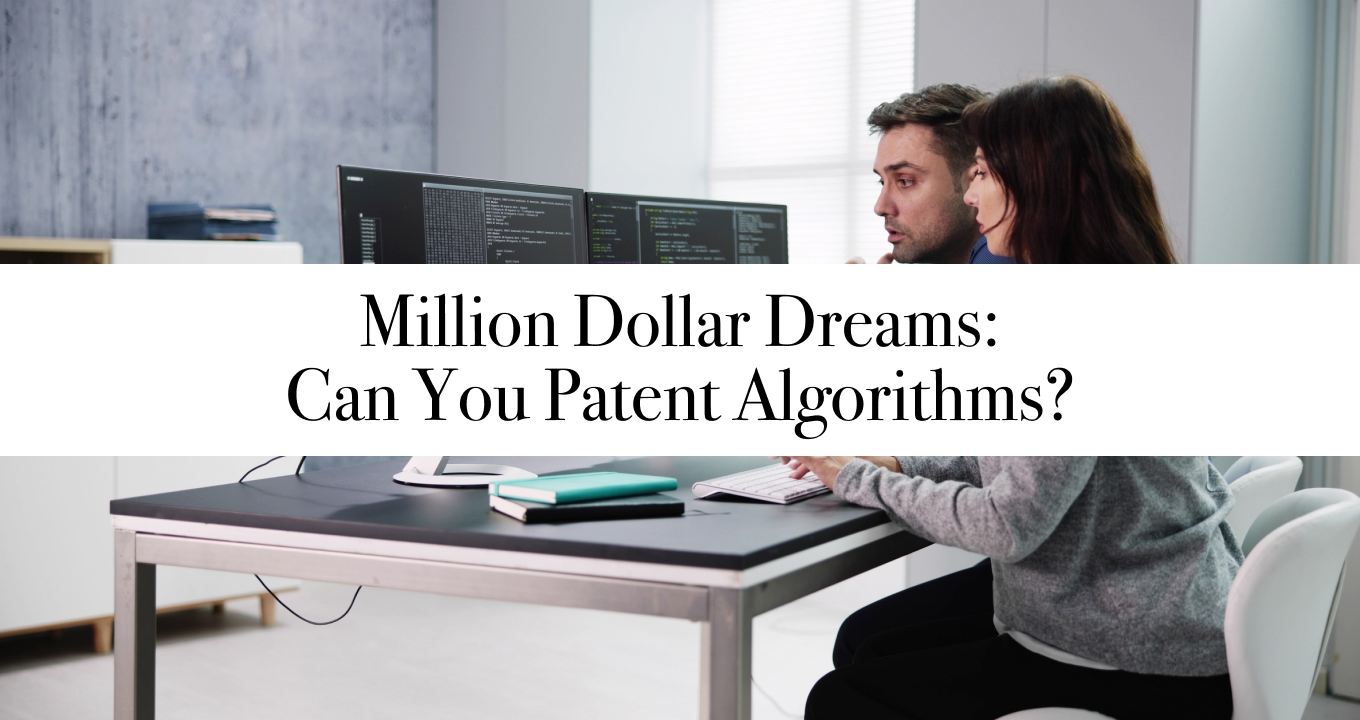Patents related to AI are emerging as the newest competitive frontier for tech innovators. Not protecting your revolutionary algorithm might enable rivals to capture your idea and obstruct your innovation.
You can patent an algorithm when you frame it as part of a concrete, functional solution. In today’s fast‐paced tech environment, protecting your intellectual property is paramount.
Patents play a critical role in protecting AI and machine learning innovations, particularly when algorithms are deployed to address specific technical problems. To qualify for AI algorithm patent protection, your algorithm must offer a tangible enhancement to computer functionality or another technological domain.
The key to successfully patenting an AI algorithm lies in how you frame and articulate your innovation. Modern patent applications must emphasize the practical implementation and technological effects rather than just the computational steps.
Key Takeaways
- Patent eligibility depends on demonstrating that an algorithm solves a defined technical problem.
- Your algorithm must contribute a measurable technological advancement beyond basic mathematical principles.
- Structuring your patent application around real-world implementation details improves the likelihood of approval.
The Crossover Between Algorithms and Patents
Innovators need more than legal theory—they need actionable strategies to safeguard their inventions. Below, we break down the core concepts behind patenting an AI algorithm and what it means for your business.
Overview of the Concept of Patenting an AI Algorithm
Algorithms can be patented when integrated into specific technical applications or physical implementations. The U.S. Patent Office assesses algorithm-based patent applications based on their practical benefits and technological contributions.
Pure mathematical formulas or abstract algorithms cannot be patented. To be eligible, an algorithm must address a tangible technical challenge or enhance computational performance measurably.
Patenting an AI algorithm means protecting how it transforms data into a practical, real-world application. Although pure mathematical formulas or abstract ideas aren’t eligible for patents, algorithms can be embedded in a specific process or device.
Definition of Algorithms
An algorithm is a structured set of instructions designed to solve a problem or accomplish a task through a finite sequence of computational steps. Algorithms form the foundation of software applications and digital processes.
From basic sorting mechanisms to advanced machine learning models, algorithms cover a broad spectrum of computational techniques. However, an algorithm must be demonstrably novel and non-obvious to qualify for a patent.
Technical algorithms process input data to generate specific outputs through defined computational pathways.
Explanation of What Constitutes an Algorithm Patent
An algorithm patent protects a specific method, process, or system that leverages an algorithm to solve a technical problem. Unlike a general patent covering tangible inventions, a patent on an algorithm must focus on the inventive application of a computational method. To qualify, your algorithm patent must demonstrate that:
- It is novel: The algorithm must be new, offering a unique method or process that hasn’t been disclosed or employed in a similar context.
- It is non-obvious: The inventive step behind the algorithm must not be an expected or routine development for someone skilled in the field. Simply applying a well-known algorithm conventionally won’t satisfy this requirement.
- It is useful and specific: The algorithm must be integrated into a real-world application that solves a concrete technical problem—resulting in measurable improvements such as increased efficiency, enhanced performance, or cost reduction. It must be part of a tangible process, system, or device that yields a clear technological benefit.
When drafting an application for an algorithm patent, detailed documentation is essential. You must clearly articulate the step-by-step process, the problem it addresses, and how the algorithm’s unique features lead to a practical, technical outcome. This comprehensive explanation demonstrates that your algorithm is more than an abstract idea—a novel, non-obvious solution with a specific, real-world application.

Patent Eligibility of Algorithms
Algorithm patentability is determined by legal criteria that distinguish abstract mathematical ideas from practical, patentable implementations. When asking, “Can you patent an algorithm?”, the answer depends on how the algorithm is framed within a functional, real-world application. Courts apply specific tests to assess technical contributions and real-world applicability.
Abstract Idea Exception
Patent offices reject claims that simply cover abstract ideas. To overcome this, you must demonstrate that your algorithm is more than a theoretical formula. It should be integrated into a specific process, device, or method that solves a real technical problem.
For example, can you patent an algorithm that optimizes battery performance in electric vehicles? Yes, because it directly improves a tangible technology.
Mathematical Methods and Algorithms
While mathematical formulas remain unpatentable, combining them with innovative hardware or unique software implementation can yield patentable inventions.
The key is to show how your algorithm interacts with technology to produce a real-world effect—whether through enhanced data encryption, improved network performance, or optimized resource allocation.
Software Patents and Algorithms
Software algorithms require carefully crafted patent applications to establish eligibility. Patent claims must center on technical solutions rather than theoretical constructs.
Key elements of a strong software patent include:
- Defined hardware interactions
- Concrete technical improvements
- Clear real-world applications
An effective software algorithm patent connects computational principles to measurable technological advancements.
The USPTO favors AI algorithm patent protection that solves well-defined technical problems or advances computational functionality beyond standard programming techniques.
Legal Framework and Practical Examples
Statutory regulations and judicial decisions shape the legal landscape for algorithm patents. Establishing eligibility requires satisfying legal criteria while adhering to established legal precedents.
Patent Law and Algorithms
Under 35 U.S.C. § 101, the U.S. Patent Act defines patentable subject matter as “any new and useful process, machine, manufacture, or composition of matter.” An algorithm must be linked to a tangible implementation or technical innovation.
Abstract mathematical formulas or theoretical models cannot be patented. An algorithm must demonstrate a real-world application that resolves a distinct technical issue.
The USPTO evaluates algorithm-related patents in two steps. First, it assesses whether a claim involves abstract principles. Second, it determines whether the implementation provides “significantly more” to render it patentable.
Federal Circuit and Case Law
Landmark cases like Alice Corp. v. CLS Bank International and Diamond v. Diehr have shaped the patent landscape for software and algorithms. In Alice, the Court emphasized that an algorithm must contribute “significantly more” than a mere abstract idea.
In Diehr, the Court approved a patent for a process that integrated a mathematical formula into a physical process. Use these cases as a roadmap: your patent must marry the abstract with a practical application.
Decisions like Enfish v. Microsoft confirm that algorithms enhancing computational efficiency or solving defined technical issues may be patentable. A well-structured AI algorithm patent protection application should highlight tangible technological benefits.
Challenges in Patenting Algorithms
Securing algorithm patents involves legal and technical challenges that require meticulous preparation and strategic positioning.
Non-Obviousness and Prior Art
Your algorithm must not only be new but also non-obvious. This means it should offer a leap in innovation compared to existing solutions. Conduct thorough prior art searches to ensure that your invention stands apart.
Document every detail of how your algorithm improves on what already exists. A well-prepared prior art review bolsters your case for novelty and minimizes the risk of infringement challenges.
Patent Application Process
Precise patent claims must define an algorithm’s implementation while avoiding abstract representations. Applications should emphasize:
- Practical applications
- Hardware interactions
- Concrete technical improvements
Examiners frequently reject algorithm patents on initial review. Expect iterative revisions to address abstraction concerns and refine technical descriptions.
Algorithms in Artificial Intelligence and Machine Learning
Due to their complexity and evolving capabilities, AI and machine learning algorithms present distinct patent challenges.
AI Algorithms and Patentability
Patent offices scrutinize AI algorithms based on their functional implementation rather than abstract logic. To qualify, an AI algorithm must demonstrate measurable technical advancements.
For example, a machine learning model that refines medical imaging diagnostics may be patentable if it introduces a novel computational technique.
Key factors influencing AI algorithm patentability include:
- Clear technical advancements
- Unique implementation strategies
- Specific hardware interactions
- Documented performance improvements
Machine Learning and Intellectual Property
Machine learning introduces complexities in AI algorithm patent protection due to adaptive model behavior. A patent application should thoroughly detail the following:
- Training methodologies
- Model architecture
- Data processing techniques
- Hardware integrations
Applications focusing on proprietary neural network architectures or advanced training methods strengthen patent claims.
Role of Patent Attorneys Concerning Machine Learning
Navigating the patent landscape for AI and machine learning requires technical and legal expertise. A seasoned patent attorney can provide clarity and guide you through the process of:
- Conducting Comprehensive Prior Art Searches: Ensure your algorithm stands apart from existing solutions.
- Drafting Clear, Robust Claims: Articulate your invention’s unique features and technical contributions.
- Responding Effectively to Office Actions: Work with patent examiners to address concerns and refine your application.
By collaborating with experts who understand both the nuances of technology and the intricacies of patent law, you significantly boost your chances of securing valuable protection for your innovations.
Future-Proof Your Innovations
If you’re an AI entrepreneur, developer, or software innovator worried about losing control over your breakthrough ideas, don’t wait. Secure your competitive advantage today by getting professional guidance on patenting your algorithm.
Amir Adibi helps with securing patents for AI, machine learning, and software innovations, transforming your intellectual property into lasting market advantages.
Contact Amir or call (925) 398-3466 to schedule your free consultation and ensure your innovation remains exclusively yours.

